Archaeology & History
Archaeologists Broke Open King Tut’s Inner Tomb Exactly 100 Years Ago. Here Are 5 of the Most Opulent Artifacts They Found
All that glitters is sometimes gold—particularly when it comes to the tomb of King Tutankhamun.
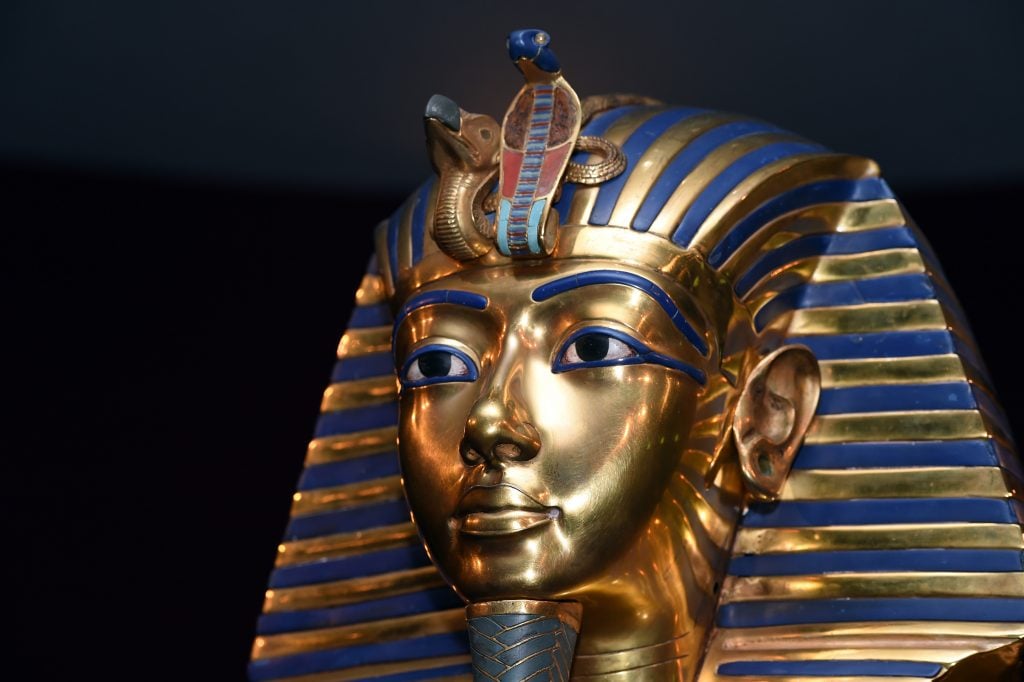
All that glitters is sometimes gold—particularly when it comes to the tomb of King Tutankhamun.

Annikka Olsen

There is perhaps no other period in human history that has captured minds and imaginations quite like ancient Egypt. “Egyptomania,” or the intense interest in all thing Egypt, was first sparked by Napoleon’s Egyptian Campaign at the turn of the 19th century. Throughout the 1800s, people across the world emulated the architecture and design of Egyptian culture—for example, Victorian-era jewelry frequently incorporated scarabs, and cartouches and monuments across Europe took the form of obelisks.
The pervasive obsession with Egypt reached an apogee when on November 26, 1922, archaeologist Howard Carter and his team discovered the doorway to the tomb of Pharaoh Tutankhamun (commonly referred to as King Tut) in the Valley of the Kings on the west bank of the Nile. Though archaeological digs had been undertaken throughout the area, most tombs had succumbed to looting and grave robbing, leaving them stripped bare of their original contents. Tut’s tomb, however, had been hidden by debris and rubble, preserving it to near perfect condition.
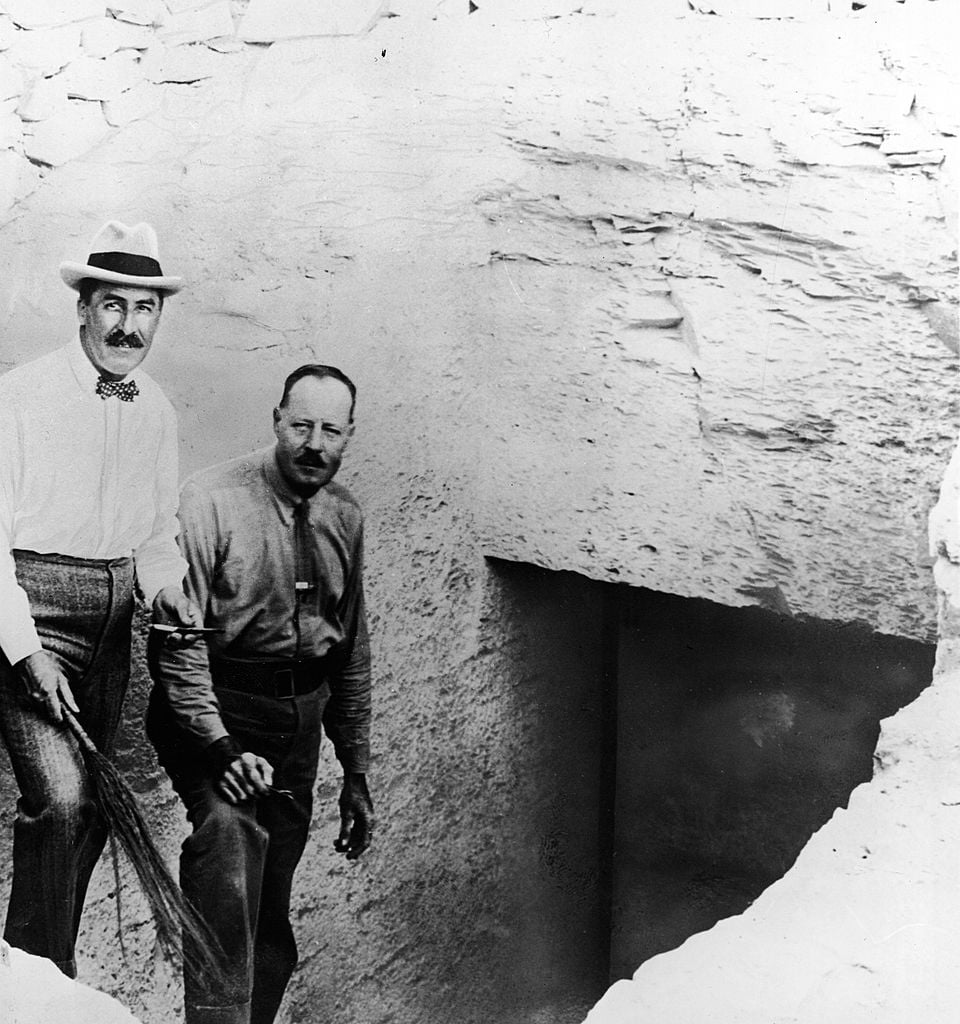
British Egyptologist Howard Carter (left) with his assistant Arthur Callender on the steps leading to the entrance to the tomb of Pharaoh Tutankhamen, Thebes, Egypt, 1922. Photo: Pictorial Parade/Getty Images.
Despite discovering King Tutankhamun’s tomb in late 1922, it took several months for archaeologists to work their way through and catalogue the contents within the outer chambers. On February 16, 1923, Carter finally came face-to-face with the doorway leading to the tomb’s inner burial chamber and unsealed it. What he and his team were met with was the most well-preserved and intact pharaonic tombs ever found. Over the following eight years, the items and goods contained therein were carefully catalogued and removed, and today are held in the collection of the Egyptian Museum in Cairo.
To mark the centennial of the unsealing of the burial chamber, we’ve gathered five of the most opulent and intriguing artifacts that were found in King Tutankhamun’s tomb.
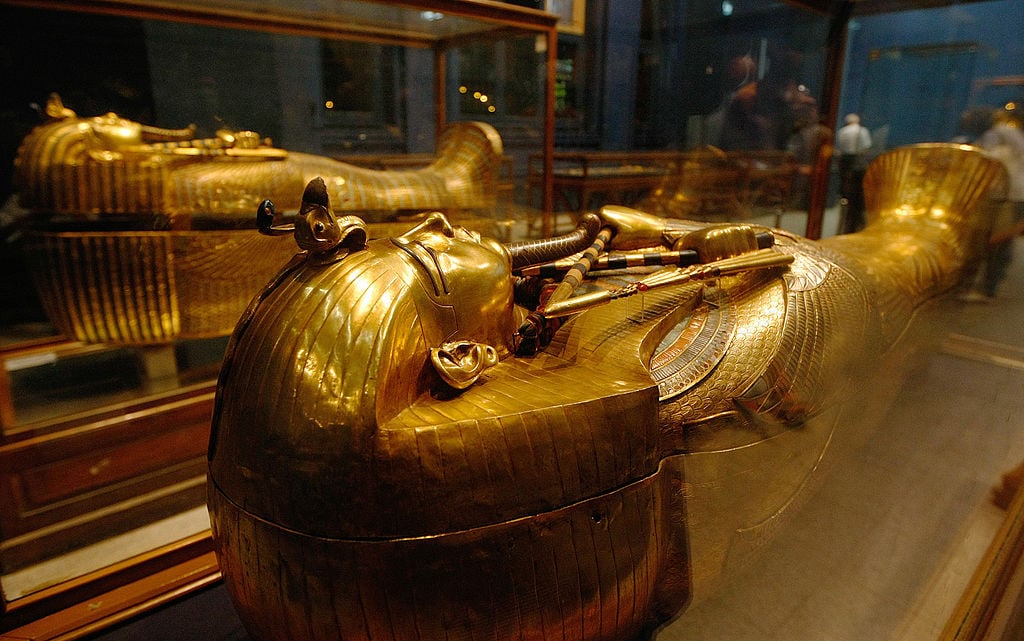
King Tutankhamun’s third and innermost coffin with the second coffin in the background. Photo: CRIS BOURONCLE/AFP/GettyImages.
Seeing the sarcophagus was perhaps one of the most exciting moments for the archaeologists at the time, as it indicated early on that the contents were preserved and intact. Crafted of quartzite and red granite, and displaying the images of Isis, Nephthys, Neith, and Serqet, the sarcophagus housed three nesting coffins which held Tutankhamun’s mummified body. The outer two coffins are made of fully gilded wood and inlaid with glass and semiprecious stones, such as turquoise and lapis lazuli. The innermost coffin, however, is made almost entirely out of 110.4 kilos of solid gold, similarly adorned with inlaid stones, and incised with inscriptions and in the shape of Osiris holding scepter and flail.
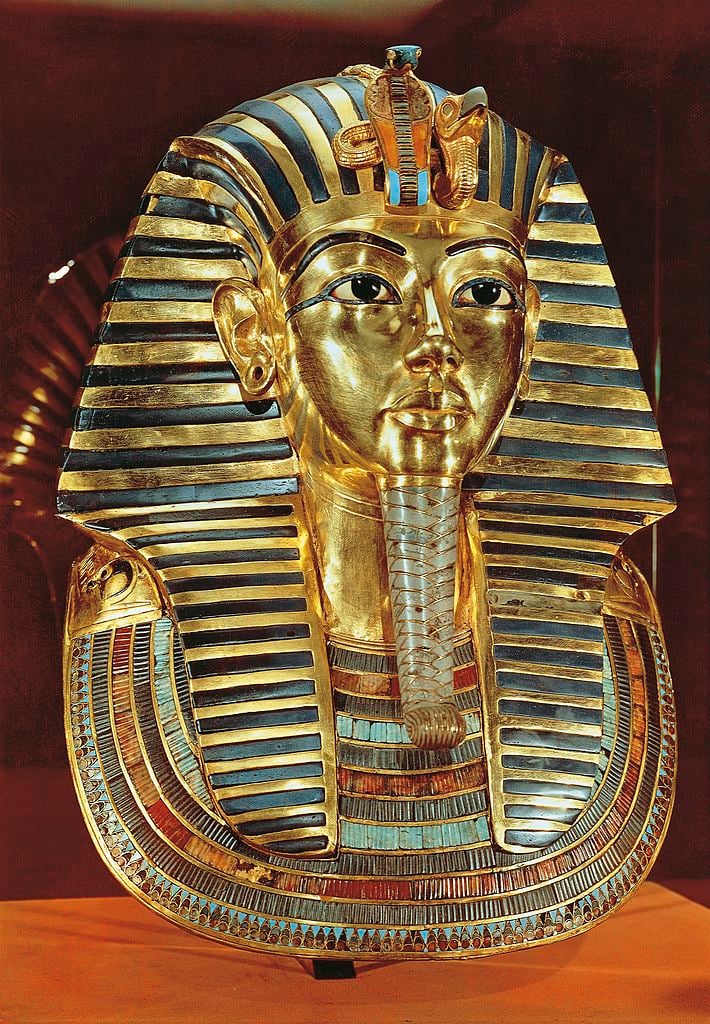
Burial mask of Pharaoh Tutankhamen. Photo: DEA PICTURE LIBRARY/De Agostini via Getty Images.
Found within the innermost coffin upon the mummified body, King Tut’s death mask has become a world-recognized icon of ancient Egypt and the pharaonic era. Composed of 10.23 kilos of solid gold, it depicts Tutankhamun wearing the traditional stripped pharaonic headdress replete with representations of the goddesses Nekhbet and Wadjet above his brow. The mask’s back and shoulders are inscribed in Egyptian hieroglyphs with a protective spell copied from the Book of the Dead, offering protection as the pharaoh moved through the underworld.
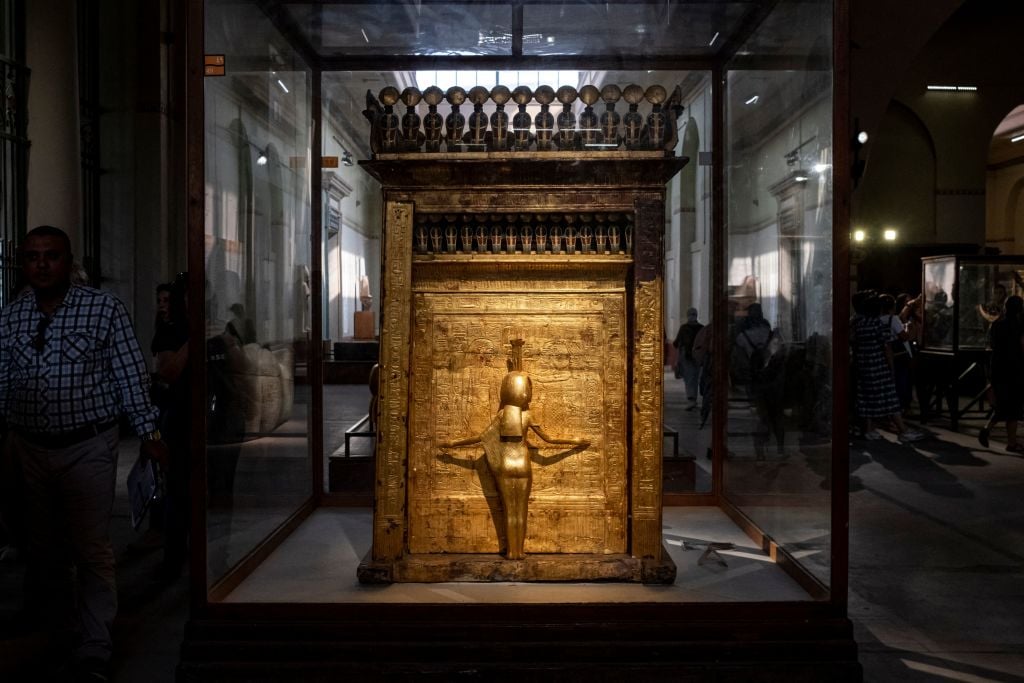
Pharaoh Tutankhamun’s Canopic Shrine. Photo: AMIR MAKAR/AFP via Getty Images.
In the process of mummification, many of the person’s organs are removed and placed in what are called canopic jars. These containers frequently included lids shaped after the heads of the Sons of Horus, protective deities. Like many other ancient Egyptian tombs, King Tut’s included an alabaster canopic chest containing the four separate jars. However, in the pharaoh’s tomb, these were housed in a canopic shrine. Standing at six-and-a-half feet tall and enrobed in gold, the shrine includes the figure of the goddess Nepthys who stands guard over the royal contents.
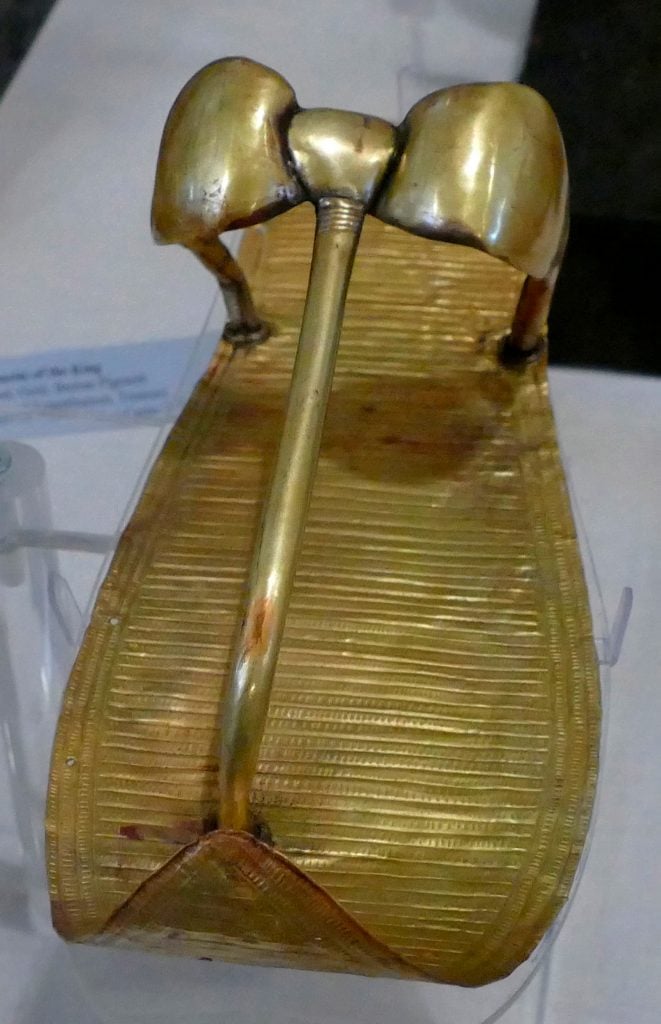
Golden sandal of King Tutankhamen. Photo: Universal History Archive/Universal Images Group via Getty Images.
A large swathe of the items found in King Tutankhamun’s tomb represented personal necessities, such as clothing, toiletries like perfume, and food stuffs. Included among these items were a pair of gold sandals. These golden shoes have been found in numerous other ancient tombs, and it is believed that they were made specifically for funerary and burial practices. The soles of the shoes depict the nine traditional enemies of Egypt, including the Nubians and Libyans, symbolizing that as god-king they were literally beneath his feet.
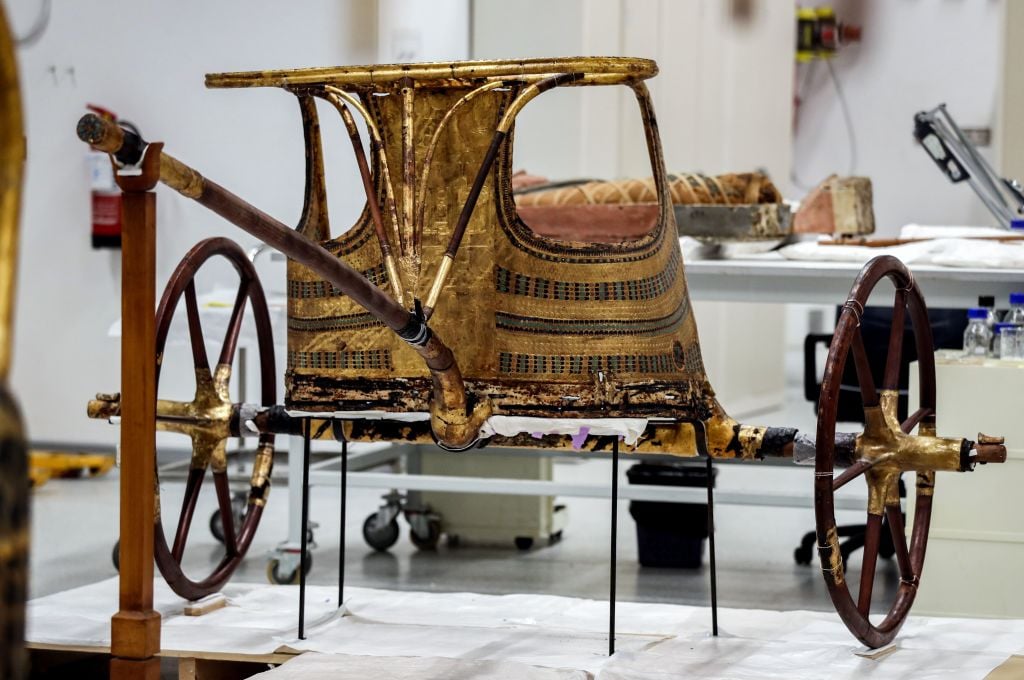
Golden chariot of Pharaoh Tutankhamun as it lies for restoration at the restoration lab of the newly-built Grand Egyptian Museum (GEM) in Giza. Photo: MOHAMED EL-SHAHED/AFP via Getty Images.
King Tutankhamun’s tomb contained a total of six golden chariots—though, unfortunately, all were in various states of disrepair as they were either mishandled or damaged by looters. After restoration, they were identified as typical D-cab chariots that were meant to be drawn by two horses. The image of a pharaoh driving a chariot was a common symbol of royal power and wealth, and in ancient times, pharaohs were often presented at public events in opulent chariots to highlight their status.
More Trending Stories:
A Revolutionary Tool Gives Artists a New Weapon in the Fight Against AI Art Theft
Brooklyn-Based Art Collective MSCHF Is at It Again, This Time With Cartoonishly Oversized Red Boots